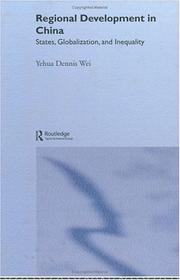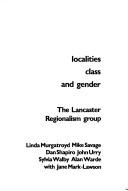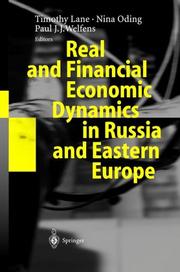| Listing 1 - 10 of 819 | << page >> |
Sort by
|
Book
Year: 1996 Publisher: Cambridge, Mass. National Bureau of Economic Research
Abstract | Keywords | Export | Availability | Bookmark
 Loading...
Loading...Choose an application
- Reference Manager
- EndNote
- RefWorks (Direct export to RefWorks)
Several recent studies have examined the tendency of regions within a nation to exhibit long-term convergence in per capita income levels. Barro and Sala-i-Martin (1991, 1992, 1995) have found a tendency towards convergence among the U.S. states, among Japanese prefectures, and among regions within Western Europe. In this paper we examine the tendency towards convergence among the provinces of China during the period 1952-1993. We find that real income convergence of provinces in China has been a relatively recent phenomenon, emerging strongly only since the reform period began in 1978. During the initial phase of central planning, 1952-1965, there is some evidence for convergence, but it is weak and sensitive to the time period being analyzed. During the cultural revolution, 1965- 1978, there is strong evidence of divergence rather than convergence. We find strong evidence for convergence during the reform period is associated with rural reforms, and is especially strong within the coastal regions where there has been liberalization of international trade and investment flows. However, since 1990 regional incomes have begun to diverge. Such a divergence is entirely explained by the variance between the coastal and interior provinces, rather than increase in variance within each other. Therefore, it seems that China is now on a dual track, with a prosperous and fast growing coastal region and a poor interior growing at a lower rate.
Book
ISBN: 9782110066640 2110066644 Year: 2007 Publisher: Paris : La Documentation française : CNRS-GDR Libergéo,
Abstract | Keywords | Export | Availability | Bookmark
 Loading...
Loading...Choose an application
- Reference Manager
- EndNote
- RefWorks (Direct export to RefWorks)
Book
ISBN: 1003339255 1003339255 1000791904 8770221251 Year: 2019 Publisher: Gistrup, Denmark : River Publishers,
Abstract | Keywords | Export | Availability | Bookmark
 Loading...
Loading...Choose an application
- Reference Manager
- EndNote
- RefWorks (Direct export to RefWorks)
Using case studies, this book encourages readers to view economic development through the lens of growing inequalities and disparities. Such inequalities are clearly becoming more obvious as the worldis better connected, and information is quickly shared. The book's main aim istherefore to direct the efforts of scholars, practitioners and policymakers toswiftly find the balance between the three pillars of sustainable development. The main challenges and focus of each chapter are different and collectively they give an integrated understanding of the phenomenon of sustainable development and its diverse aspects.
Book
ISBN: 0429555067 0429264518 0429559534 Year: 2021 Publisher: Abingdon, Oxon ; New York, NY : Routledge,
Abstract | Keywords | Export | Availability | Bookmark
 Loading...
Loading...Choose an application
- Reference Manager
- EndNote
- RefWorks (Direct export to RefWorks)
This book sheds light on the mega-city region development in China as a new form of urbanization which plays a crucial role in the economic development of the country. It examines the challenges faced by the mega-city regions and opens up avenues for debates and further research. Economic reform of 1978 has led to an unprecedented growth in the population and economic development of China. A large portion of this increased urban population and the corresponding economic growth has been concentrated in the mega-city regions, such as Beijing-Tianjin-Hebei (BTH), Yangtze River Delta (YRD) and Pearl River Delta (PRD). These three mega-city regions have less land but more people and thus higher economy, resulting in various issues and challenges faced by these regions. These challenges pertain to the socio-economic development, transport, environment, governance and development strategy, which this book explores through case studies of Guangdong-Hong Kong-Macao Greater Bay Area, Beijing-Tianjin-Hebei and Wuhan. This book also explains and analyses the economy, migration processes, transport development, environmental conditions and governance of the mega-city regions of China. With an overview of China's rapid urbanisation and the consequent economic growth, this book provides an essential understanding of related issues in order to establish appropriate strategies and policies to sustain the process of mega-city region development.
Book
Year: 1983 Publisher: Washington, D.C. : United States Department of Agriculture, Economic Research Service,
Abstract | Keywords | Export | Availability | Bookmark
 Loading...
Loading...Choose an application
- Reference Manager
- EndNote
- RefWorks (Direct export to RefWorks)

ISBN: 0415224489 0203184661 1134591268 1280402075 0203190424 9780203190425 9780203184660 9780415224482 9786610402076 6610402078 9781134591268 9781134591213 1134591217 9781134591251 113459125X 9781280402074 Year: 2000 Publisher: London New York Routledge
Abstract | Keywords | Export | Availability | Bookmark
 Loading...
Loading...Choose an application
- Reference Manager
- EndNote
- RefWorks (Direct export to RefWorks)
This study systematically examines uneven regional development in China, focusing on three central agents: the foreign investor, the state and the region. Wei's findings have important implications for theories of, and policy towards, Chinese regional development. This book is a vital resource for those with an interest in transition economies.
Regional disparities --- China --- Economic conditions --- Regional disparities. --- Economic policy
Book
Year: 2008 Publisher: [Washington, D.C. : World Bank,
Abstract | Keywords | Export | Availability | Bookmark
 Loading...
Loading...Choose an application
- Reference Manager
- EndNote
- RefWorks (Direct export to RefWorks)
"Brazil's inequalities in welfare and poverty across and within regions can be accounted for by differences in household attributes and returns to those attributes. This paper uses Oaxaca-Blinder decompositions at the mean as well as at different quantiles of welfare distributions on regionally representative household survey data (2002-03 Household Budget Survey). The analysis finds that household attributes account for most of the welfare differences between urban and rural areas within regions. However, comparing the lagging Northeast region with the leading Southeast region, differences in returns to attributes account for a large part of the welfare disparities, in particular in metropolitan areas, supporting the presence of agglomeration effects in booming areas. "--World Bank web site.
Household surveys --- Income distribution --- Poverty --- Regional disparities. --- Regional disparities.

ISBN: 0850861152 Year: 1985 Publisher: London Pion
Abstract | Keywords | Export | Availability | Bookmark
 Loading...
Loading...Choose an application
- Reference Manager
- EndNote
- RefWorks (Direct export to RefWorks)
Women --- Employment --- Regional disparities --- Great Britain --- Economic conditions --- Regional disparities.

ISBN: 3540009108 Year: 2003 Publisher: Berlin Springer
Abstract | Keywords | Export | Availability | Bookmark
 Loading...
Loading...Choose an application
- Reference Manager
- EndNote
- RefWorks (Direct export to RefWorks)
Europe, Eastern --- Russia (Federation) --- Economic conditions --- Regional disparities --- Regional disparities.
Book
ISBN: 3923887094 Year: 1988 Publisher: Kiel Geographisches Institut der Universität Kiel
Abstract | Keywords | Export | Availability | Bookmark
 Loading...
Loading...Choose an application
- Reference Manager
- EndNote
- RefWorks (Direct export to RefWorks)
Schleswig-Holstein (Germany) --- Economic conditions --- Regional disparities. --- Regional disparities --- Maps.
| Listing 1 - 10 of 819 | << page >> |
Sort by
|

 Search
Search Feedback
Feedback About UniCat
About UniCat  Help
Help News
News